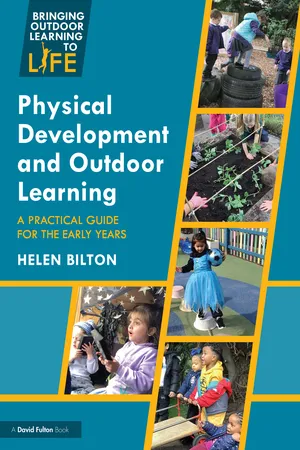
Physical Development and Outdoor Learning
A Practical Guide for the Early Years
- English
- ePUB (mobile friendly)
- Available on iOS & Android
About this book
Physical development is the window to the whole child. Through watching children move, they reveal their true selves.
This groundbreaking book bridges the gap between theory and practice, offering a deeper understanding of young children's physical development in outdoor environments. It explores the specific phases of motor development, the skills children acquire and how these are closely linked to cognitive growth.
This resource provides clear and accessible guidance on promoting children's well-being, the links between language and physical development, creating environments that encourage growth, and emphasising the adult's role in supporting and facilitating progress.
Written for those working with children aged 2–6, this book serves as a practical reference guide for staff, offering adaptable resources, or as a starting point for additional study and research. Topics covered include:
- The importance of physical development.
- Stages of growth, development and maturity.
- Creating environments that nurture physical development.
- The role of the adult.
- Supporting parents and caregivers.
- Making achievable and measurable changes.
Featuring full-colour photographs, activities and rich case studies, this book equips early years educators with the tools they need to fully support children's physical development in outdoor settings.
Frequently asked questions
- Essential is ideal for learners and professionals who enjoy exploring a wide range of subjects. Access the Essential Library with 800,000+ trusted titles and best-sellers across business, personal growth, and the humanities. Includes unlimited reading time and Standard Read Aloud voice.
- Complete: Perfect for advanced learners and researchers needing full, unrestricted access. Unlock 1.4M+ books across hundreds of subjects, including academic and specialized titles. The Complete Plan also includes advanced features like Premium Read Aloud and Research Assistant.
Please note we cannot support devices running on iOS 13 and Android 7 or earlier. Learn more about using the app.
Information
Table of contents
- Cover
- Half Title
- Series
- Title
- Copyright
- Contents
- List of Figures
- Acknowledgements
- Series Foreword
- Introduction
- 1 What is physical development and why is it important?
- 2 Enabling environments
- 3 Skilled educators
- 4 Partnership with parents
- 5 Making changes
- References
- Appendix 1: Skills of Motor Development
- Appendix 2: Phases and stages of motor development
- Appendix 3: Language and Moving
- Appendix 4: Motor development (Gallahue) and movement factors (Laban) mapped
- Appendix 5: Three examples of intentional play opportunities
- Appendix 6: “Can you …?” cards
- Appendix 7: Guidelines for movement sessions
- Appendix 8: Four Examples of Movement Sessions
- Appendix 9: Situations where motor skills are explicitly taught whether it be locomotor, non-locomotor or manipulative skills during free play
- Appendix 10: Parental Survey about Physical Development
- Appendix 11: Framework for making changes to provision
- Appendix 12: Summary of Locomotor and Manipulative Development Sequences
- Index